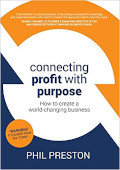|
|
|
|
|
|
|
|
|
Dear reader,
Welcome to the May 2020 edition of The Director's Dilemma. Our world continues to adapt to pandemic measures and directors are under stresses that they certainly did not expect to be under. It is more important than ever before that our boards are a benefit and not a burden for our organisations.
Following the case study is an opportunity for you to participate in some research to evaluate the current costs and return on investment of our boards. Your input will be most gratefully appreciated.
Our May dilemma concerns a not-for-profit board that has a welcome problem; more candidates for director roles than they can safely handle! The three contributors have provided a great range of ideas in response to the dilemma which includes possible conflicts of interest and potential associations between directors. The sort of situation that happens in real life but isn't covered in the literature because it seems too far-fetched! I hope that you enjoy their insights and find them helpful in extending your governance knowledge.
Please remember that my twenty-one years' experience consulting to, and sitting on, boards, is available to you if you should need to seek counsel on how to proceed or if you wish to hold a board performance review, strategy workshop, or director education session via technology; physical distancing does not mean that you can't develop your board's cohesion.
To read this email in a browser, go to www.mclellan.com.au/newsletter.html and click on 'read the latest issue'.
 Vance chairs the board of a NFP company that helps disadvantaged children. Like many NFP chairs, he tries to pull together a skills-based board of passionate volunteers. He has been combing his network for a lawyer with the right passions and skills for the past 12 months. Vance chairs the board of a NFP company that helps disadvantaged children. Like many NFP chairs, he tries to pull together a skills-based board of passionate volunteers. He has been combing his network for a lawyer with the right passions and skills for the past 12 months.
Two months ago, an acquaintance offered to introduce him to someone who sounded perfect. The introduction was made, and the prospective director was everything Vance had been hoping for. The conversation moved onto families and Vance learned that his prospect was married to another lawyer with a very similar background; they had met at work and, although they were now at different firms, still practiced in similar areas.
Vance told the board about his meeting with their potential new colleague and they agreed that the prospective director be given a nomination pack and invited to stand for election.
Five days ago Vance received two completed nominations. Both spouses want to join the board. He has gone from no legal expertise to the offer of two qualified lawyers who both appear exactly what he needs. He just isn't sure that he wants both of them, or how to choose between them if he doesn't take both.
Vance doesn't want to hurt anyone's feelings. He has checked his constitution and the Corporations Act; there doesn't seem to be anything about husbands and wives serving on boards together.
What should Vance do, and how can he best proceed without upsetting two very generous people who truly want to help the company?
|
|
|
|
Robert’s Answer
It is not unusual for Chairs to scour their networks for potential directors. As many as 65% of director roles in Australia are filled without going to a formal recruitment stage, so Vance's dilemma is not uncommon. For Vance, his challenge comes in the form of practicing good leadership and ensuring good governance practices.
There are two levels of conflict for Vance to consider. Vance has a potential internal conflict of not wanting to hurt anyone which may impair his judgement. Vance also has a potential conflict of interest as he has met the directors individually outside of a formal nominations process and has formed a somewhat biased view, i.e. this is the perfect director to fill this position.
Working in the best interest of the organisation, I would advise Vance to immediately step back and hand over the process to an independent director or (nomination) committee to ensure proper process. He also needs to be clear that the final decision will be a joint one, not his alone.
Although the prospect of recruiting two highly sought-after directors to your non-profit board is tantalising, the board and/or committee should consult their skills matrix, review the role requirements, and decide if they actually need two lawyers. They should also consider broader factors such as relevance of past experience, diversity and interpersonal skills.
The board could also consider offering a position on a committee for the unsuccessful candidate with a view of nomination at the next intake.
In the worst case scenario having aligned directors, such as family members, can impair independence in discussion and decision making, create voting blocks and hamper processes if one director needs to be stood down. If both are appointed, I would advise the whole board to discuss and develop strategies to minimise these types of issues before they arise.
Robert Crowe is Chairman of Connect Child and Family Services and Managing Director of Leading for Purpose. He is based in Sydney , Australia.
|
|
|
|
Julie's Answer
 There is no law against married couples being members of the same board. This is rarely covered in constitutions although some constitutions require directors to be independent of other directors and members of staff. There is no law against married couples being members of the same board. This is rarely covered in constitutions although some constitutions require directors to be independent of other directors and members of staff.
Directors must act independently of each other and never act as a unit. Having a voting block, even if only two, seriously reduces a board's ability to reach informed consensus.
The board needs to access diverse skills and experiences to enrich debate and enhance decision-making. Two board members from the same generation, with similar professional backgrounds and skills, and living in the same geographic and socio-economic environment, inevitably reduces overall board diversity.
People aren't lego-bricks. Feelings may be hurt if he declines one candidate. Vance could be in a situation where his board gets both or neither.
Vance needs to balance the undoubted value that these candidates offer against the next skills needed under his board's succession plan. Can the board operate effectively without those skills? What will be the impact on the projected skills matrix for the next nine years?
Finally Vance needs to evaluate the board's processes. Does the nomination pack suggest that completing the paperwork automatically leads to standing for election (or appointment to a casual vacancy)? Does the board want to include a nominations committee to get more strategic in targeting skills? How are conflicts of interest registered, declared and managed? Is the current process good enough to handle issues arising from a married couple both on the board? Can the chair manage discussions well enough?
If the systems and succession plan can cope Vance should cope also.
Julie Garland McLellan is a non-executive director and board consultant based in Sydney, Australia.
|
|
|
|
Keith's Answer

Having a married couple in any organization has its challenges and certainly this is no different on a Board of Directors.
It is advisable to always be sure to undergo an independent search process to insure that your organization is seeing the top talent the market has to offer, unbiassed consul on available candidates and a proven process for selection.
In this case, consider: why this family have a passion for this organization? what is reasoning for them both to apply? Posing these questions to them, you may find one of the spouses withdraws rather quickly when they speak to each other. Assuming they are of equal abilities and fit, this removes the dilemma. If they have solid reasoning it becomes trickier.
Having a married couple on a board would certainly create potential conflict of interest. On the other hand (as most married couples would attest to) they don't always agree and could work in a constructive and absolutely independent manner. A major consideration also is the size, breadth and revenue of your NFP and are there major contracts awarded? If so, can they be in anyway influenced by the board? This being the case, it could be called into question if a contract is awarded where they have some personal gain. Even though this conflict is no different than on any board of directors, it could create a major issue.
If the board has two seats available don't look a gift horse in the mouth. So long as their intentions are sound and their skills are relevant. This could provide your organization with a power couple fundraising/PR “dynamic duo”.
Keith Labbett is Co-founder and Co-chair of The Canadian University Mens Rugby Championship and Managing Partner of Osprey Executive Search. He is based in Toronto, Canada.
|
|
|
|
What does your board cost and is it good value? - Most boards have limited or no awareness of their true cost. Especially in the NFP sector where directors often feel that because they are not remunerated the board is 'cost-free'. In the listed sector shareholders vote each year on a pool of money from which the company may pay directors' fees.
The cost of a board far exceeds that visible cost. Senior executives spend considerable time preparing information for the board, writing agendas, papers and minutes, tracking down information, managing “housekeeping” (conflict of interest and consent to act statements, directors shareholding notices, the logistics of board travel and meetings, etc.), and interacting with directors in committee, board, or one-on-one meetings.
The cost of that time and other intangibles is rarely tracked and few boards are aware of their total cost. In 2013 I conducted research into the cost of time spent reporting to, supporting, and administering their company's board.
Your help bringing that research up to date is greatly appreciated. Your best estimate - if you don't track time and cost for board support - is sufficient. Your comments and questions are welcome. Take the survey here.
|
|
|
|
Book Review – Connecting Profit With Purpose by Phil Preston.
 Why is this book of interest to company directors? Many directors struggle to distinguish Corporate Social Responsibility, sustainable business practices, and philanthropic activities from shared value. This book makes the distinction clear and then provides a thorough yet simple methodology for creating shared value in any organisation or endeavour. Why is this book of interest to company directors? Many directors struggle to distinguish Corporate Social Responsibility, sustainable business practices, and philanthropic activities from shared value. This book makes the distinction clear and then provides a thorough yet simple methodology for creating shared value in any organisation or endeavour.
The book defines shared value as “contributing to positive societal outcomes through core and profitable business.” It sets the scene for the shift in mindset and behaviour that's needed if businesses and society are to go hand in hand instead of head to head.
When a new trend comes along, most directors try and catch on as quickly as we can. We are, after all, responsible for progress, wealth creation, and governance and will be held accountable for any lack of any of these. Often, there appears to be a tension between governance and wealth creation or progress. This book resolves that tension.
The author, Phil Preston, has deep experience in driving shared value projects and shares many anecdotes that bring the concepts to life. One of my favourites was “When asked what the business benefit was, the default answer would invariably be “People will see that we are doing good things in the community and they'll buy more of our products”, which invited the question “How do you actually measure and attribute those benefits?” This was usually met with silence.
If you aspire to do good and make money, then this book will fuel your enthusiasm and show you how to use it. If you only aspire to one of those outcomes, this book will challenge your ideas about your own, and your organisations', purpose. Either way, you will benefit from this book.
Available on amazon.com.
Phil and I have worked together on delivering strategic programs to help boards and executive teams collaborate and create meaningful strategic results. If you are interested in exploring the potential for your organisation to benefit from better collaboration please call or email me.
Julie's News - In April
 Well, it was a busy month in spite of the Lockdown. I delivered some online education for directors and boards including directors mentoring, induction programs, and workshops on a ariety of matters that boards felt necessary at this time.
Well, it was a busy month in spite of the Lockdown. I delivered some online education for directors and boards including directors mentoring, induction programs, and workshops on a ariety of matters that boards felt necessary at this time.
I also attended online board and committee meetings for my own portfolio of boards.
In addition I completed some work on CEO recruitment for a not for profit company and started to develop the outline for my next book.
Ovet the past five weeks I have become more proficient at using Zoom, Microsoft Teams, Go to Webinar, Citrix, Redback, and Skype for business. I expect that you have also.
I am always happy to help if your board has a need. Just call me on +61 411 262 470 or reply to this email for a discussion of how I might help your board.
Inspirational quote for May - This month my favourite quote is from John F Kennedy. I felt it pertinent in these times when many are lamenting the economic cost of measures to protect societal health. Let's remember to laugh and celebrate what we can.

A note on names - A few readers have asked me where I find the names for the protagonists in each case study; I 'borrow' them from people I meet or things that I read. Vance is an ancient English name; it means 'marshland'. Our protagonist will do well not to get bogged down in this issue and to lead his board through the complex environment in which it operates aided by, and without distractions from, its own governing body.
This newsletter - If you have any ideas for improving the newsletter please let me know. If you are reading a forwarded copy, please visit my website and sign up for your own subscription.
Suggestions for dilemmas - Thank you to all the readers who have suggested dilemmas. They are greatly appreciated. I will answer them all eventually. I could not write this newsletter without your help and without the generous help of all the experts who respond each month to the case studies.
Be a contributor - If you would like to attempt a response to the dilemmas for publication you will be most welcome. Simply reply to this email and let me know.
Let's connect - I use LinkedIn to share information about boards and directorship with my friends and acquaintances. If you use LinkedIn and we are not yet connected I will welcome a connection from you. You can find me at linkedin.com/in/juliegarlandmclellan.
Let me help you - If you would like me to speak to or train your board, staff, audience and/or group please contact me at julie@mclellan.com.au.
Farewell until the next issue due 1 June 2020. I look forward to greeting you again then. In the interim I hope you will enjoy health, happiness and hard work: Enjoy governing your companies; we are privileged to do what we do and every day is a blessing!
Best regards,
Julie

Photo Credits: Personal images in this newsletter are provided courtesy of the contributors, course attendees and conference participants.
Disclaimer:
The opinions expressed above are general in nature and are designed to help you to develop your judgement as a director. They are not a definitive legal ruling and do not constitute legal advice. Names and some circumstances in the case study have been changed to ensure anonymity. Contributors to this newsletter comment in the context of their own jurisdiction; readers should check their local laws and regulations as they may be very different.
Privacy: I am privileged to have your contact details and keep them as safely as possible. I will alert you if they are ever accessed by any unauthorised person (the technical staff at ayuda help with publishing and issuing the Director's Dilemma and have access so they can send the newsletters to you). I do not sell your details to anyone; they are kept only for the intended purpose - sending you this newsletter and helping to build the judgement of company directors by providing a safe way to consider potential responses to real life events.
Main Photo by Andrea Piacquadio from Pexels
|
|
|
|
|
|
|
 Vance chairs the board of a NFP company that helps disadvantaged children. Like many NFP chairs, he tries to pull together a skills-based board of passionate volunteers. He has been combing his network for a lawyer with the right passions and skills for the past 12 months.
Vance chairs the board of a NFP company that helps disadvantaged children. Like many NFP chairs, he tries to pull together a skills-based board of passionate volunteers. He has been combing his network for a lawyer with the right passions and skills for the past 12 months.
 There is no law against married couples being members of the same board. This is rarely covered in constitutions although some constitutions require directors to be independent of other directors and members of staff.
There is no law against married couples being members of the same board. This is rarely covered in constitutions although some constitutions require directors to be independent of other directors and members of staff.

 Well, it was a busy month in spite of the Lockdown. I delivered some online education for directors and boards including directors mentoring, induction programs, and workshops on a ariety of matters that boards felt necessary at this time.
Well, it was a busy month in spite of the Lockdown. I delivered some online education for directors and boards including directors mentoring, induction programs, and workshops on a ariety of matters that boards felt necessary at this time.
